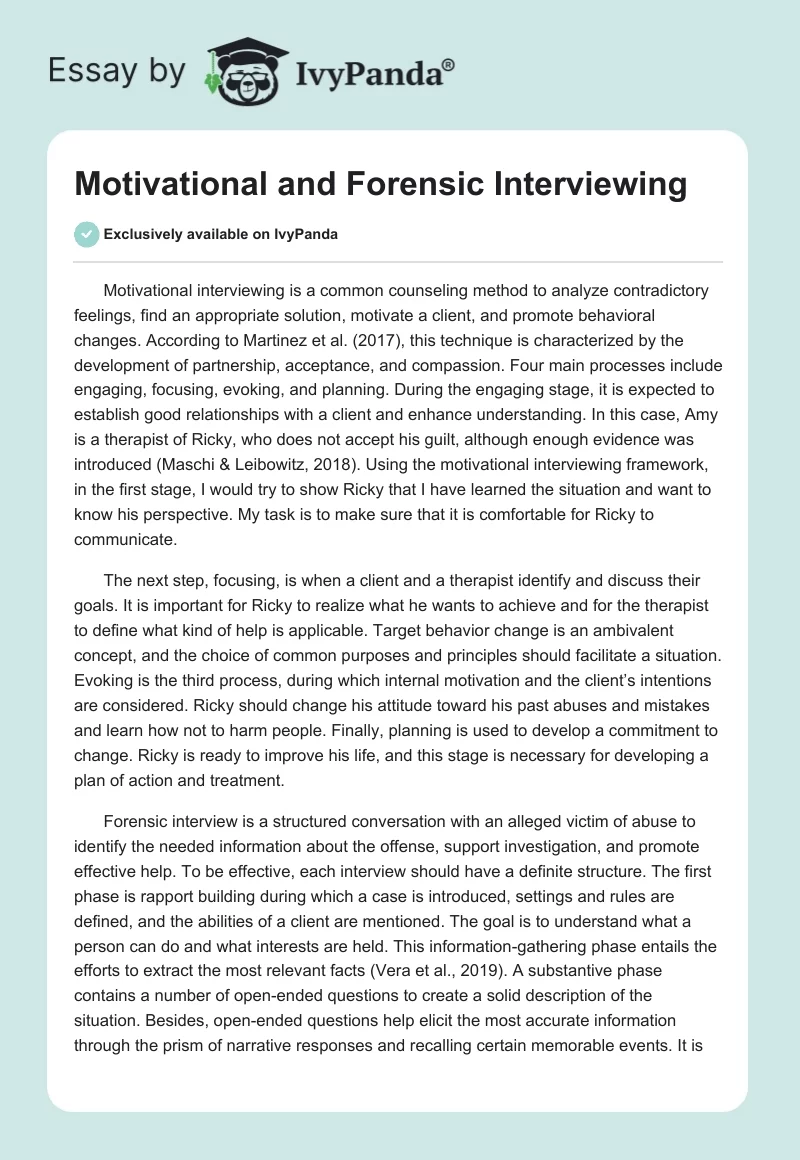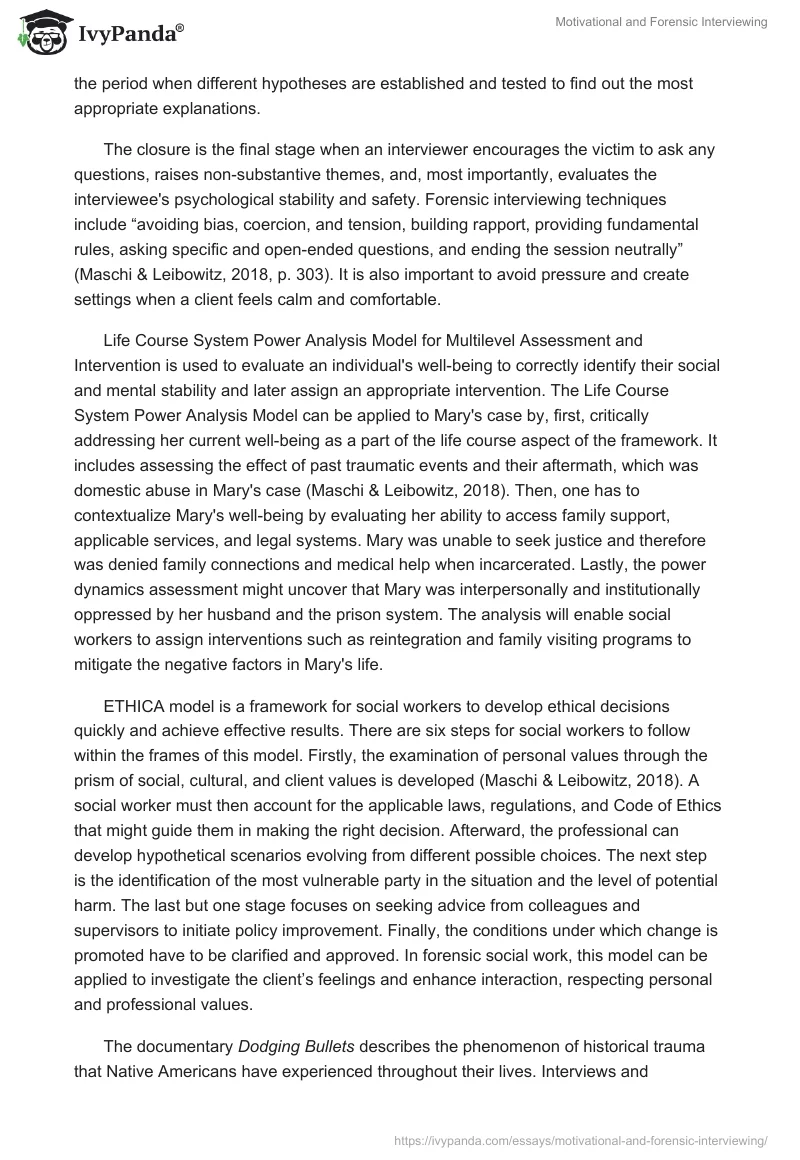Motivational interviewing is a common counseling method to analyze contradictory feelings, find an appropriate solution, motivate a client, and promote behavioral changes. According to Martinez et al. (2017), this technique is characterized by the development of partnership, acceptance, and compassion. Four main processes include engaging, focusing, evoking, and planning. During the engaging stage, it is expected to establish good relationships with a client and enhance understanding. In this case, Amy is a therapist of Ricky, who does not accept his guilt, although enough evidence was introduced (Maschi & Leibowitz, 2018). Using the motivational interviewing framework, in the first stage, I would try to show Ricky that I have learned the situation and want to know his perspective. My task is to make sure that it is comfortable for Ricky to communicate.
The next step, focusing, is when a client and a therapist identify and discuss their goals. It is important for Ricky to realize what he wants to achieve and for the therapist to define what kind of help is applicable. Target behavior change is an ambivalent concept, and the choice of common purposes and principles should facilitate a situation. Evoking is the third process, during which internal motivation and the client’s intentions are considered. Ricky should change his attitude toward his past abuses and mistakes and learn how not to harm people. Finally, planning is used to develop a commitment to change. Ricky is ready to improve his life, and this stage is necessary for developing a plan of action and treatment.
Forensic interview is a structured conversation with an alleged victim of abuse to identify the needed information about the offense, support investigation, and promote effective help. To be effective, each interview should have a definite structure. The first phase is rapport building during which a case is introduced, settings and rules are defined, and the abilities of a client are mentioned. The goal is to understand what a person can do and what interests are held. This information-gathering phase entails the efforts to extract the most relevant facts (Vera et al., 2019). A substantive phase contains a number of open-ended questions to create a solid description of the situation. Besides, open-ended questions help elicit the most accurate information through the prism of narrative responses and recalling certain memorable events. It is the period when different hypotheses are established and tested to find out the most appropriate explanations.
The closure is the final stage when an interviewer encourages the victim to ask any questions, raises non-substantive themes, and, most importantly, evaluates the interviewee’s psychological stability and safety. Forensic interviewing techniques include “avoiding bias, coercion, and tension, building rapport, providing fundamental rules, asking specific and open-ended questions, and ending the session neutrally” (Maschi & Leibowitz, 2018, p. 303). It is also important to avoid pressure and create settings when a client feels calm and comfortable.
Life Course System Power Analysis Model for Multilevel Assessment and Intervention is used to evaluate an individual’s well-being to correctly identify their social and mental stability and later assign an appropriate intervention. The Life Course System Power Analysis Model can be applied to Mary’s case by, first, critically addressing her current well-being as a part of the life course aspect of the framework. It includes assessing the effect of past traumatic events and their aftermath, which was domestic abuse in Mary’s case (Maschi & Leibowitz, 2018). Then, one has to contextualize Mary’s well-being by evaluating her ability to access family support, applicable services, and legal systems. Mary was unable to seek justice and therefore was denied family connections and medical help when incarcerated. Lastly, the power dynamics assessment might uncover that Mary was interpersonally and institutionally oppressed by her husband and the prison system. The analysis will enable social workers to assign interventions such as reintegration and family visiting programs to mitigate the negative factors in Mary’s life.
ETHICA model is a framework for social workers to develop ethical decisions quickly and achieve effective results. There are six steps for social workers to follow within the frames of this model. Firstly, the examination of personal values through the prism of social, cultural, and client values is developed (Maschi & Leibowitz, 2018). A social worker must then account for the applicable laws, regulations, and Code of Ethics that might guide them in making the right decision. Afterward, the professional can develop hypothetical scenarios evolving from different possible choices. The next step is the identification of the most vulnerable party in the situation and the level of potential harm. The last but one stage focuses on seeking advice from colleagues and supervisors to initiate policy improvement. Finally, the conditions under which change is promoted have to be clarified and approved. In forensic social work, this model can be applied to investigate the client’s feelings and enhance interaction, respecting personal and professional values.
The documentary Dodging Bullets describes the phenomenon of historical trauma that Native Americans have experienced throughout their lives. Interviews and discussions are the main data gathering methods to learn life and understand the traumas. The main idea is to show how the targeted population was victimized and abused throughout a significant historical period by other ethnicities and races, which accumulated into current psychological trauma and institutional repression (Trench, 2018). The concept of historical trauma among the representatives of the indigenous community provides enough insights on how to identify and deal with challenges under specific circumstances. Native Americans were confined to the disadvantaged regions of reservations, unfairly segregated from the White population, socially excluded, and denied many Constitutional rights. Historical trauma knowledge helps forensic social workers work with vulnerable populations, comprehend the worth of dignity, and deal with stress.
References
Martinez, C. C. P., Arnaout, B., & Martino, S. (2017). Fundamentals of motivational interviewing. In P. Levounis, B. Arnaout, & C. Mariendeld (Eds.), Motivational interviewing for clinical practice (pp. 15-34). American Psychiatric Association Publishing.
Maschi, T., & Leibowitz, G. S. (2018). Forensic social work (2nd ed.). Springer.
Trench, B. (2018). Dodging bullets [Film]. Intercontinental Cry.
Vera, L. M., Boccaccini, M. T., Laxton, K., Bryson, C., Pennington, C., Ridge, B., & Murrie, D. C. (2019). How does evaluator empathy impact a forensic interview?Law and Human Behavior, 43(1), 56-68. Web.


